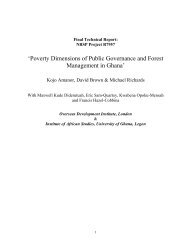The Gambian Tourist Value Chain and Prospects for Pro-Poor Tourism
The Gambian Tourist Value Chain and Prospects for Pro-Poor Tourism
The Gambian Tourist Value Chain and Prospects for Pro-Poor Tourism
Create successful ePaper yourself
Turn your PDF publications into a flip-book with our unique Google optimized e-Paper software.
<strong>Tourism</strong> in <strong>The</strong> Gambia: International ‘Best Practice’ in Poverty Reduction & <strong>Pro</strong>-<strong>Poor</strong> Growth Through <strong>Tourism</strong><br />
Draft Report (Friday 22 nd December 2006)<br />
6 Exp<strong>and</strong> the <strong>Tourism</strong> Sector<br />
Exp<strong>and</strong>ing the tourism sector will increase the dem<strong>and</strong> <strong>for</strong> goods <strong>and</strong> services provided by<br />
everyone engaging directly or indirectly with the tourism value chain in <strong>The</strong> Gambia,<br />
including the poor. As described in Sections 4 <strong>and</strong> 5, the poor are already accessing a<br />
significant slice of the tourism value chain <strong>and</strong>, with targeted interventions, the size of this<br />
slice could increase significantly.<br />
In this section some of the key obstacles to the growth of tourism in <strong>The</strong> Gambia will be<br />
outlined – together with some suggestions as to how to overcome them.<br />
<strong>Pro</strong>blems are examined from two perspectives, that of the international travel industry<br />
looking at <strong>The</strong> Gambia from overseas <strong>and</strong> the perspective from stakeholders within the<br />
destination.<br />
From an industry perspective, major constraints include:<br />
• Malaria;<br />
• <strong>Poor</strong> <strong>and</strong> unreliable infrastructure;<br />
• Lack of choice in accommodation; <strong>and</strong><br />
• Lack of marketing support.<br />
From a destination perspective, the main constraints include:<br />
• Seasonality of dem<strong>and</strong>;<br />
• Accessibility;<br />
• Inadequate infrastructure;<br />
• Lack of marketing <strong>and</strong> promotional support;<br />
• Lack of training; <strong>and</strong><br />
• Inadequate governance.<br />
<strong>The</strong>se perceived obstacles to tourism growth will be examined in turn – together with<br />
practical strategies to overcome them.<br />
6.1 Malaria<br />
Whilst the SWOT analysis in the <strong>Tourism</strong> Strategy of 2002 made no mention of malaria, the<br />
dominant international tour operator <strong>for</strong> <strong>The</strong> Gambia cited this as the largest single risk<br />
facing the destination. Significantly, this operator is diversifying destinations to include<br />
malaria-free Cape Verde. <strong>The</strong>re is some evidence that this malaria might be increasing <strong>for</strong><br />
two reasons.<br />
First, international tour operators will be sending more flights during the 2006/07 winter<br />
season than in the past. For the 26 week winter season, there will be ten flights a week<br />
from the UK - equating to 50,000 arrivals just from the UK this winter. In the absence of<br />
effective marketing initiative, a likely consequence of an increase in the supply of airline<br />
seats is heavy discounting by charter companies to fill seats <strong>and</strong> consequent late bookings.<br />
Cheap late bookings carry a disproportionate risk of malaria because tourists may not have<br />
time - or be inclined - to spend £50 on the malaria prophylactics on a discounted holiday<br />
package costing £350.<br />
Second, as <strong>The</strong> Gambia successfully develops into a year-round destination, this will<br />
inevitably result in more tourists arriving during the higher malaria-risk summer rainy<br />
season.<br />
42

















